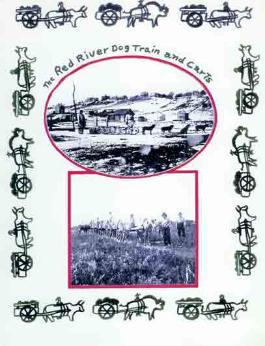Getting goods in the early days must have been a problem. You couldn't sit down at your phone and order up anything you wanted. You couldn't get on the computer and mystically see the merchandise pictured, press a few keys and have it arrive in a few days. Sometimes we don't realize how good we have it!
What we would think of as early van lines was dog sleds bringing merchandise from up north to the Mississippi headwaters, which is what St. Paul was called. This consisted of furs and various Indian handcrafts, with the journey taking about 16 days.
However, there was a definite need for better transportation, so in the early 1800s the Red River cart was invented. For many years it was the main vehicle in bringing furs from two major trading posts, Pembina and Ft. Garry. Being as how the first cart trains followed Indian trails, which in turn ran parallel to waterways, the favored route was by the Red River, and that is where the carts got their name.
The Red River rises in Elbow Lake, flows southwest to Breckinridge, then north, forming the boundary of Minnesota and North Dakota. From Pembina, close to the Manitoba border, the river flows north to Ft. Garry, which is a bit south of Lake Winnipeg, Canada.
There were several men/companies credited with inventing the Red River cart. One was Alexander Henry of the Northwest Company. Another was the Canadian Fur Company. Yet another was Norman W. Kittson at his trading post in Pembina. Regardless of who invented them, they were all constructed in a similar pattern.
The carts were two-wheeled and made entirely of wood and leather. The wheels at first were rounds of trees with straps of rawhide stretched around for wheels. Later, they had spokes. The various parts were fastened together with thongs of buckskin or buffalo hide. Each cart was provided with 8 ft. poles, between which was an ox harnessed in rawhide. Tame buffalos or cows were also used and each wrangler had charge of several animals.
The biggest problem with the Red River carts was that they were noisy. They didn't have axel grease back then to quiet the sound of wood rubbing on wood, and the squeaking of the carts, when loaded with 600 to 1000 lbs. of raw furs, could be heard for miles. There were often 100 carts in a train, so you could imagine the din it would cause.
It was told that one minister at a St. Anthony church, who had just started his sermon, heard the carts coming and knowing it took hours for a train to pass, dismissed the congregation until the following week.
The train could usually travel 12 to 15 miles a day and they camped at regular stops. The whole round trip took about three months. The drivers were mixed Indian and French descent, with a full-blood white as a train master. They made a colorful procession, as some wore suits of buckskin with red sashes and beaded moccasins, and some wore blue cloth suits decorated with brass buttons. A coonskin cap with tail or a bead-work cap finished the outfit.
The men never left Pembina in the spring until the native grasses had grown tall enough for their animals to eat. The traders existed on pemmican. In case you have to go on a long trip, here is the recipe: First, boil up some buffalo meat, dry it on a rack under which a fire is built, then beat it into small pieces. Press it into a sack made of buffalo skin and pour a good quantity of melted buffalo fat and bone marrow into it. When it cools, sew the sack shut, and in this manner it will keep for three to four years. Never mind about it being red meat and saturated fat-and don't worry about the fat turning rancid-the traders claimed it was very nourishing! Strangely enough the sled dogs, years before, ate the same diet at the rate of one pound of pemmican per dog per day, usually being fed at night. And, oh yes, each bag weighed from 100 to 150 pounds.
In 1865 a prominent pioneer family, the Rufus Farnhams, built a large house between Washington Ave. and the river near 40th. They reported that the Red River carts went right through their yard on a trail between their home and the Mississippi. There must have been a lot of carts going through there because it was reported that $250,000 worth of furs were brought in that year.
The fur trade continued until after the Civil War and every year until 1867. As the country was settled and land was cleared, the fur-bearing animals were scared away and the trappers moved on to new territories. Adding to that, the Northern Pacific Railroad was completed to the Red River and with that event, the once famous carts passed into history!
Note: Excerpts taken from Personal Recollections of Minnesota and It's People and Early History of Minneapolis by John H. Stevens-1890 and Old Rail Fence Corners by F.H. Me Cullouch-1914
Barbara Meyer Bistodeau
